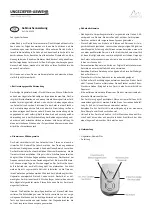
Engine Control System (4HK1) 1A-353
Cuts Out
Checks
Action
Definition:
A constant jerking that follows the engine speed, usually more pronounced as the engine load increase. The
exhaust has a steady spitting sound at idle, low speed, or hard acceleration for the fuel starvation that can cause
the engine to cut-out.
Preliminary Check
• Diagnostic System Check - Engine Controls.
• Inspect that the harness connectors are correctly connected.
• Inspect the ECM grounds for being clean, tight, and in their proper
locations.
• Inspect the Scan Tool Data List in this section.
• Inspect the Service Bulletin.
Sensor Checks
Inspect the engine control sensors for the following conditions. Refer to the
Scan Tool Data List in this section.
• Observe the Mass Air Flow (MAF) parameter for a skewed or slow MAF
sensor.
• Observe the Fuel Rail Pressure (FRP) Sensor parameter with the engine
OFF. The FRP Sensor should read 0.9 to 1.0 volt with the ignition switch ON
and engine OFF after the engine has stopped running for a minimum of 1
minute. If not, check for high resistance in each circuit or for a skewed
sensor.
• Observe the Fuel Rail Pressure and Desired Fuel Rail Pressure parameter
between idle and W.O.T. (accelerator pedal full travel) in Neutral. Fuel Rail
Pressure parameter should follow within
±
5 MPa (
±
725 psi) quick enough.
• Observe the Accelerator Pedal Position (APP). APP parameter should
change linearly from 0 to 100% according to the accelerator pedal
operation.
• Crankshaft position (CKP) sensor is tight and the sensor rotor is not
damaged.
Fuel System Checks
Inspect the fuel system for the following conditions. Refer to Fuel System
Check chart and appropriate procedure in Section 1D Engine Fuel.
• Air in the fuel system.
• Water contamination in the fuel.
• Fuel waxing or icing.
• Fuel filter clogging.
• Fuel leak off from the fuel pressure limiter valve and fuel injectors.
• Fuel lines between the fuel tank and fuel supply pump for being crushed,
kinked, tightness, cracks and plugged.
• Inside the fuel tank for any foreign material that may be getting drawn into
the fuel line pickup causing a blocked condition.
• Perform the Cylinder Balance Test with a scan tool.
• Perform the Injector Force Drive with a scan tool.
• Observe the Fuel Compensation for each cylinder at idle on the scan tool.
Air Intake System Checks
Inspect the air intake system for the following conditions.
• Air cleaner, air intake ducts and charge air cooler for a restriction, holes, or
leaks.
• A restriction in the turbocharger inlet duct.
• Intake throttle valve for a stuck condition.
• A restriction or leak in the intake manifold.
LG4HKED-WE-0871.book 353
ページ
2007年11月29日 木曜日 午後6時29分
















































